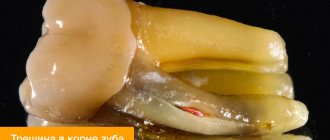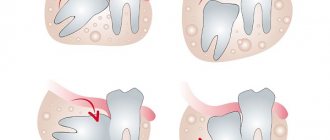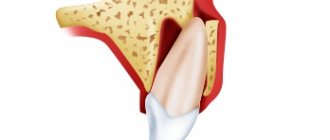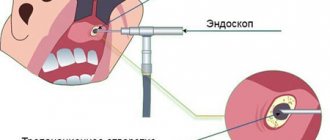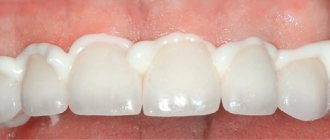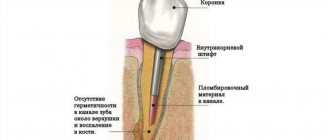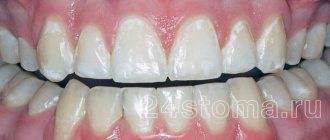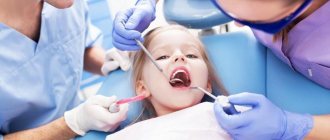A tooth crack is a common occurrence; surface cracks (craze lines) are relatively common. In most cases they do not cause problems. But sometimes a cracked tooth leads to cracked tooth syndrome. It is difficult to diagnose and often causes frustration for both the dentist and the patient.
Pulpal and periapical diagnosis depends on the extent of the fissure and the duration of symptoms. The dental pulp can become inflamed due to microleakage, which causes thermal sensitivity. Propagation of the crack can eventually lead to irreversible pulpitis.
Causes of cracked teeth
The force of pressure on the teeth when chewing reaches 400 kg/cm². Healthy and strong crowns can easily cope with such a load. If the enamel is weakened or excessive pressure is applied, the tooth can crack. Factors contributing to the appearance of cracks in teeth:
- malocclusion, bruxism;
- depulpation (removal of a nerve);
- absence of one/several teeth (uneven load distribution);
- deep caries (destruction of 50% of the crown or more);
- injuries (fall, blow to the face, accident);
- genetically determined weakness of tooth enamel;
- poor nutrition leading to a lack of fluoride, calcium, phosphorus;
- excess sugar in the diet;
- temperature changes when eating (cold-hot);
- habit of biting pens and nails;
- teeth whitening at home;
- traumatic treatment of dental canals, excessive tightening of braces.
Important! Teeth with weakened enamel may crack when eating hard foods (such as crackers). However, chipped teeth more often occur due to prolonged exposure to adverse factors.
Dial-Dent specialists who took part in the treatment:
- Orthopedic dentist A.S. Ivankov – installation of a pin tab, dental prosthetics with a ceramic crown.
- Implant surgeon V.P. Alaverdov – removal of the broken part of the tooth, laser treatment of the gums.
- Dentist-endodontist Yu.A. Borisova – inspection of a crack with a microscope, treatment of tooth canals with a microscope.
- Dental technician D.V. Wolf – making a ceramic dental crown.
- Neurologist E.V. Saxonova – diagnosis of neurological problems.
- ENT doctor A.V. Arkhandeev – diagnostics of ENT problems.
- Dental assistants – A. Antoshkina, M. Erkimbekova.
- Center administrators – coordinating appointments with specialists, reminders about the visit.
See other examples of the work of Family Dental specialists here.
Make an appointment for a consultation by phone +7-499-110-18-04 or through the form on the website. You can ask questions about dental prosthetics to the chief doctor of the clinic, Sergei Vladimirovich Tsukor, at
How to tell if a tooth is cracked
When a tooth cracks, patients notice a click. However, it is not always possible to see a crack with the naked eye, and pain often appears later. If a tooth is cracked and puts pressure on the gum, soft tissue swelling occurs and inflammation develops.
Bacteria enter the pulp through destroyed enamel. Patients note increased sensitivity to hot/cold foods and complain of pain when closing their jaws. Bad breath appears in the absence of caries. When chewing, the crack enlarges and, without treatment, leads to a tooth fracture or provokes severe pain due to nerve damage.
Important! A brown or black crack on a tooth indicates that food debris and bacteria have entered deep into the crown. Even damage to the enamel that is not noticeable at first leads to the development of caries.
Saving the tooth of the chief physician of Dial-Dent S.V. Zukora
It so happens that even good dentists themselves need dental treatment. Our chief physician S.V. Zukor had a toothache. Or rather, this tooth had been hurting for a long time. Periodically, once or twice a week, while chewing, a short but very intense painful shooting occurred in the teeth of the upper jaw on the right. The pain was short and very intense. After a couple of seconds everything passed. Nothing was found during the examination. A thorough visual examination of all the teeth in this area, x-rays and computed tomography of the teeth revealed nothing. Our specialists could not find the source of the pain. The cause of pain in the teeth, that is, toothache, can be not only problems with the teeth. Often diseases of the ENT organs or neurological symptoms are disguised as toothache. That is why the Family Dental Clinic employs both a neurologist and an ENT doctor, who are involved in diagnosis in complex cases. Tsukor S.V. was examined by these doctors, who gave an expert opinion that everything was normal with the neurological and ENT systems.
So, after all, teeth! But nothing is visible. The tactics of observation and wait were chosen. Yes, painful impulses were repeated, but nothing could be done until the exact cause of the pain was identified. Monitoring was carried out throughout the year, periodically repeating examinations.
What to do if a tooth is cracked
In this case, you need to urgently make an appointment with a dentist. A timely visit to an experienced dentist will increase the chances of saving a cracked tooth and reduce the cost of treatment. Please follow these guidelines before visiting the dental clinic.
- Do not probe the crack with your tongue or touch the tooth with your hands.
- Avoid chewing load on the injured crown.
- Every hour, rinse your mouth with an antiseptic, a decoction of medicinal herbs (chamomile, sage) or a weak saline solution (0.5 tsp per glass of water at room temperature).
These measures will prevent the crack from enlarging and the introduction of infection into the tooth pulp.
Is it possible to save a cracked tooth?
It all depends on the scale of the damage: the depth and length of the crack, its location. Solving the problem on your own with the help of folk remedies and toothpaste will not give an effect, and delaying professional treatment will only worsen the situation.
Important! Cracked teeth do not heal.
To assess the possibility of restoring a cracked tooth and choose the optimal treatment method, each specific case should be considered separately.
Only the tooth enamel is cracked
Enamel cracks are minimal damage to the integrity of the tooth, almost invisible to the naked eye. The dentist will carefully polish the crown, gradually removing microscopic layers, and remineralize it with fluoride-containing gel. However, treatment should not be delayed. Consequences of cracks in tooth enamel: caries, increased damage in depth and, as a result, inflammation of the nerve.
Important! Before treating a cracked tooth, Matisse Dent dentists perform an antiseptic treatment of the oral cavity. The procedure destroys pathogenic bacteria. The success of treatment and the service life of the restored tooth depend on this.
Reviews
Elena
spent a long time looking for a dentistry where doctors would not instill fear before starting treatment. And of course, the prices should be reasonable. Dentistry “14×14” suited me as a patient just perfectly. Good specialists, competent and courteous. I recommend.Vladimir
I was worried about a crack in my tooth. The dentists at the 14×14 clinic provided advice and perfectly selected a method for restoring the unit. There were no complications. Everything went as comfortably and painlessly as possible. Thank you very much for your work!
A longitudinal (vertical) crack appeared on the tooth
Shallow cracks along the tooth that do not extend under the gums are eliminated with a composite material and subsequent installation of veneers. Thin overlays mask the aesthetic defect and strengthen the crown, preventing its further destruction. Molars experience increased chewing load, so cracks on them require the use of ceramic/zirconium crowns.
A deep vertical crack often leads to pulpitis. In this case, it is necessary to remove the nerve and carry out a step-by-step reconstruction of the tooth (filling, veneer or crown).
With a strong impact, a vertical crack extends to the root of the tooth. It is possible to restore a tooth if the root is at least one third intact, and the patient immediately seeks help. An attempt to save a dead tooth in this way with partial damage to a single root (incisors, canines and sometimes premolars) often leads to the gradual destruction of the entire root system. In such cases, the only correct option is tooth extraction and subsequent prosthetics/implantation.
Important! Since a pulpless tooth does not receive nutrition, the enamel quickly loses its strength. Therefore, it is advisable to install a crown on a cracked tooth without a nerve (the root is not damaged).
Horizontal tooth crack
A crack surrounding a tooth often does not affect the pulp, so the nerve can be preserved. Tooth restoration includes the use of a composite and restoration with crowns or veneers (front only). Without timely treatment, a transverse crack leads to partial chipping of the tooth. The dentist builds up the broken area with a composite material.
A high risk of tooth loss is caused by a horizontal crack formed at the gum line. In this place the tooth is most vulnerable; the crown can completely (or most of it) break off even from a small load. In fact, the tooth is lost, but it is quite possible to restore it using extensions on pins and restoration using a ceramic crown.
Important! If, after an impact and complete loss of the crown, the roots of the tooth become very loose, there is no point in restoring the tooth. Gradually it will fall out along with the unstable roots.
Tooth root crack
The defect is formed from the root to the edge of the tooth and is diagnosed only on an x-ray. With internal chipping, the risk of soft tissue necrosis and jaw fracture increases. If the crack damaged only one tooth root, partial preservation of the natural crown is possible. Part of the damaged tooth is removed and then built up using pins and composite. In this case, it is advisable to create additional protection and install a metal-ceramic crown. Removal cannot be avoided if the only tooth root is cracked.
Tooth cracked in half
With this type of damage, both walls of the tooth are most often affected. Even the slightest load causes severe pain. Treatment depends on the degree of damage to the root part. If a tooth is cracked diagonally and a large fragment is loose, the unstable part is removed and the crown is restored. In cases where the tooth is cracked in half to the root (gum level), and its parts remain stable, treatment is carried out according to the standard algorithm (composite, veneer or crown). Looseness of both parts of a split tooth indicates destruction of the root along its entire length. In such a situation, careful tooth extraction is performed.
Important! A tooth that is cracked in half can break at any time.
A child's baby tooth is cracked
Most often, defects in baby teeth are caused by feeding with cow's milk (calcium is poorly absorbed) and excessive consumption of sweets. The dentist will grind down the chewing cusps. This reduces the load and removes the damaged tooth from the chewing process. If the child is left untreated, the fragments will cause gum inflammation and may damage the emerging permanent teeth.
Important! Deep cracks in permanent teeth in children require endodontic treatment (nerve removal) followed by filling. However, such a procedure does not exclude tooth destruction in the future.
A pregnant woman's tooth cracked
Damage to tooth enamel is an entry point for infection. Therefore, any dental problems for expectant mothers must be treated in the second trimester of pregnancy. A cracked tooth is no exception. If a split appears on a previously treated tooth, first replace the failing filling and repair the crack with a composite material, then install a crown. A temporary filling is not advisable in this case. Treatment of cracked teeth in pregnant women is carried out according to the usual algorithm for adult patients, with the exception of implantation.
Important! To treat a cracked tooth in a pregnant woman, anesthetics that are safe for the unborn child are used.
Cracked wisdom tooth
Wisdom teeth are more exposed to an acidic environment, and therefore cracks, chips and caries often appear on them. These crowns do not participate in the chewing process and are difficult to access for quality treatment. Therefore, when cracks appear, experts recommend removing wisdom teeth.
To avoid losing a cracked tooth, make an appointment with your dentist as soon as the damage is discovered and use only experienced dentists. The high level of the clinic is evidenced by the certificates of doctors and customer reviews. Matisse Dent specialists use modern methods of treating cracked teeth and will do everything to save your tooth.
Making a ceramic crown
The permanent dental crown was made in the dental laboratory of the Dial-Dent clinic by dental technician D.V. Ceramic wolf E.max. Photographs of teeth in different modes were used to give the technician maximum information to recreate the color.
The dental technician will match the color of the crown to make it indistinguishable from natural teeth in your mouth.
Having our own laboratory in our center simplifies many tasks related to dental prosthetics and makes all stages better and more predictable. All necessary corrections and fittings are made in the presence of a technician!
Permanent ceramic crown, material – E.max ceramics:
